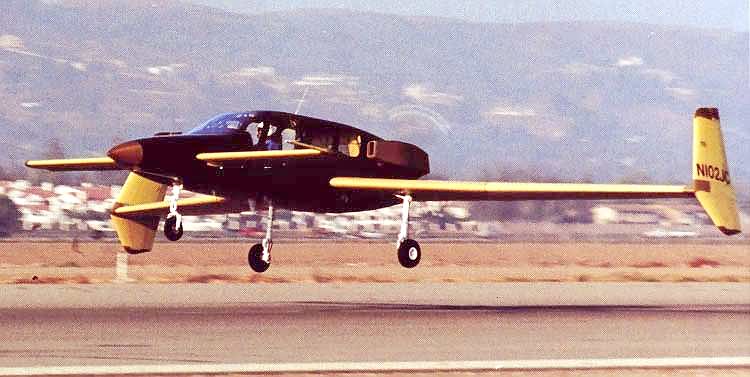
AASI Jetcruzer
This single engine turboprop aircraft developed by Advanced Aerodynamics and Structures Inc. (AASI) is easy to recognise: it has a canard configuration with a pusher prop at the end of the fuselage. The air intakes are to either side of the rear fuselage. The Jetcruzer has vertical stabilisers placed at the wing tips.
Jetcruzer 450
The first version is the smallest of the two. The Jetcruzer 450 has large cockpit windows and two cabin windows. The vertical stabilisers are tilted inward a bit. The part above the wings is about twice as big as the part below the wings.
The key features of the Jetcruzer 450 are the large cabin windows and vertical stabilisers up and down from the wing tips. (photo Bernhard C.F. Klein Memorial Collection - 1000aircraftphotos.com)
Jetcruzer 500
The stretched Jetcruzer 500 has smaller cockpit side windows than the 450, and four cabin windows. The inward tilt of the vertical stabilisers is much smaller and they are only extending up from the wing tips. Additionally, the Jetcruzer 500 has a ventral fin.
The Jetcruzer 500 has smaller cabin windows and vertical stabilisers only up from the wing tips.
Confusion possible with
Cirrus/Israviation ST50
The ST50 also has a pusher prop in the rear fuselage and is of similar size as the Jetcruzer 450. However, the ST50 has a conventional configuration with a true cruciform tail at the end of the fuselage.
Beechcraft Starship
Like the Jetcruzer the Beech Starship has a canard configuration and vertical stabilisers at the end of the wings. The main difference however is the number of engines: the Jetcruzer has one while the Starship has two, on top of the wings.
Avtek 400
Like the Jetcruzer the Avtek 400 has a canard configuration. However the Avtek 400 has a single vertical stabiliser. Also the canard is placed above the cockpit. (photo: Peter Davis)





